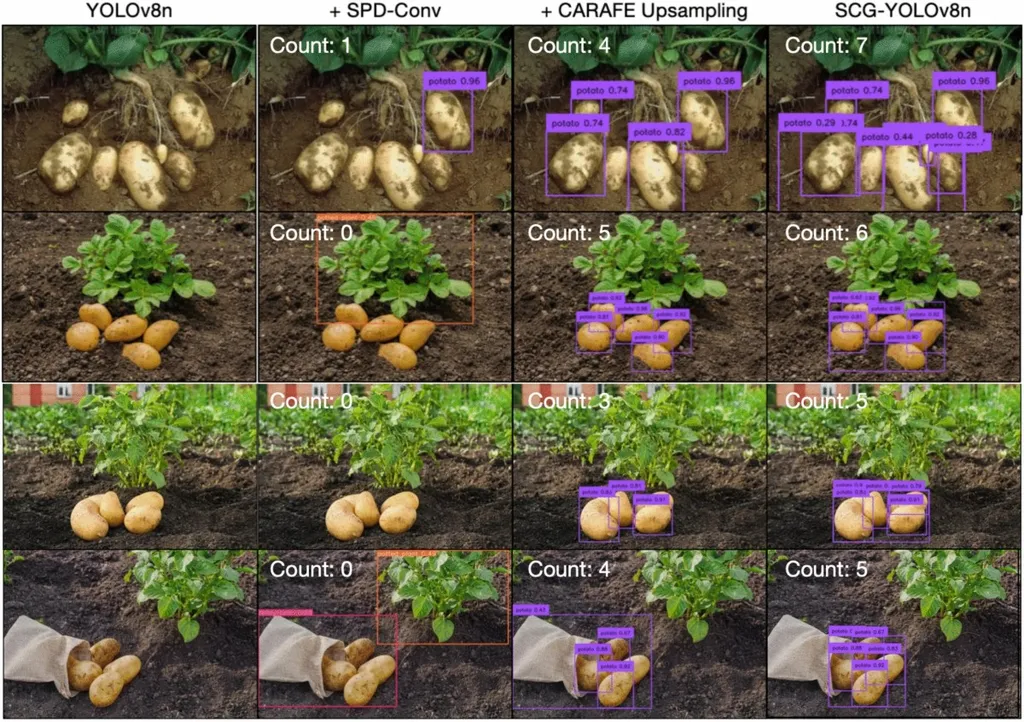In the heart of China’s agricultural innovation, a groundbreaking framework is set to revolutionize potato farming, offering a glimpse into the future of precision agriculture. Leichao Du, a researcher from the Gansu Academy of Agricultural Engineering Technology, has developed SCG-YOLOv8n, a compact and field-adapted detection framework designed to tackle the unique challenges of potato counting during early harvest. This innovation, published in the esteemed journal Scientific Reports (translated as “Nature Research Reports”), promises to enhance yield estimation, automate sorting, and support data-driven agricultural decisions.
The SCG-YOLOv8n framework is built upon the YOLOv8n architecture and is specifically tailored for small-object detection in real-world farming conditions. “Field environments present practical challenges such as soil occlusion, overlapping tubers, and inconsistent lighting that hinder robust visual recognition,” explains Du. To overcome these obstacles, the model incorporates three practical enhancements: a C-SPD module that preserves spatial detail to improve recognition of partially buried tubers, an S-CARAFE operator that reconstructs fine-scale features during upsampling, and GhostShuffleConv layers that reduce computational overhead without sacrificing accuracy.
The implications of this research extend far beyond the potato fields. The SCG-YOLOv8n framework demonstrates the potential for lightweight, efficient models to drive advancements in precision agriculture. “Through extensive field-based experiments, SCG-YOLOv8n consistently outperforms YOLOv5n and its base version across all key metrics,” Du notes. The model’s ability to compress to just 3.2 MB through Float16 quantization enables real-time inference on Android devices, making it a practical and scalable tool for farmers.
One of the most compelling aspects of this research is the development of the PotatoDetector mobile application. This app, which leverages the SCG-YOLOv8n framework, has shown stable performance in field trials, achieving an RMSE of 1.38 and an R² of 0.96 in counting tasks. “These results suggest that SCG-YOLOv8n offers a practical and scalable tool for precision agriculture, with potential applicability to other root and tuber crop monitoring scenarios,” Du explains.
The commercial impacts of this research are significant. By enabling real-time, accurate counting of potatoes, farmers can make more informed decisions about harvesting, sorting, and selling their crops. This not only improves efficiency but also has the potential to increase profitability. Moreover, the lightweight nature of the SCG-YOLOv8n framework makes it accessible to a wide range of farmers, regardless of their technological resources.
Looking ahead, the SCG-YOLOv8n framework could shape future developments in the field of precision agriculture. Its success in potato detection suggests that similar models could be developed for other crops, further enhancing the capabilities of farmers worldwide. As Du puts it, “The potential for this technology is vast, and we are excited to explore its applications in other areas of agriculture.”
In conclusion, the SCG-YOLOv8n framework represents a significant step forward in the field of precision agriculture. Its innovative approach to potato detection, combined with its practical and scalable nature, makes it a valuable tool for farmers. As research in this area continues to evolve, the potential for similar technologies to drive advancements in agriculture is immense, offering a glimpse into a future where data-driven decisions are the norm.

